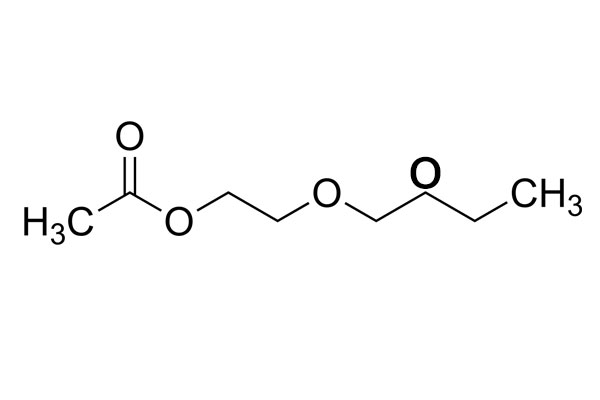Cas No: 124-17-4
EINESC No: 204-685-9
Molecular weight: 204,27 g/mol
Chemical Formula: C10H20O4
Chemical Structure:
Physical Properties
General Properties: colorless liquid
Odor: fruity
Intensity: 0,98 g/cm3
Boiling point: 246 °C
Melting point: -32 °C
Flash point: 0,98 °C
Vapor pressure: <0,01 hPa (20 ° C)
Refraction index: 1,4260 (20 ° C)
Solubility (aqueous) 64 g/L 20°C
Viscosity:

General Properties
Butyldiglycol acetate can also be called diethylene glycol monobutyl ether or diethoxol acetate. Its abbreviation is BDGA and it is a chemical compound that belongs in carboxylic acid esters group. It can initiate reactions with characteristics of ethers and esters due to ether bridges and ester groups. It has fruity and delicate scent. Although it dissolves in water in low amounts, it may be mixed in any amount with other organic solvents.
Production
BDGA is generally produced by reaction of ethylene oxide and ahydrous n-butyl alcohol. Then, these ethers are handled by acetic acid in order to create butyl di glycol acetate.
Applications
BDGA is mostly used in dyes, cleaning liquids, coatings and inks. In coating industry, it is used as latex connective for water-based industrial coatings.
In dyeing business, it works as high boiling solvent and agalizator and it is used as connective for stains. For cleaning liquids, it is an effective solvent and in electronics, it is marketed as a cleaning product. In ink industry, it is a commonly used solvent for special inks. It is also used in wood stains and furniture stains. It can also be used as a plasticizer.
Safety Measures and Toxic Values
BDGA is extremely hazardous for aquatic life. It should not be left to environment after it is purified. Prolonged exposure may lead to dryness and cracks on skin.